Fundamental Principles of Electrophoresis
Faint Bands, High Background
A high background which obscures the bands, or in combination with fainter than usual bands, indicates dye binding to the gel matrix, or contamination of the matrix with a dye-binding material (most often a protein). Coomassie Blue R-250: Destaining time too short: It takes hours for the dye to completely diffuse out of the gel…
Read MoreFaint bands, low background
Faint bands over a low background with standard Coomassie Blue R-250 staining can be caused by a number of factors: (scroll down for Colloidal Coomassie troubleshooting) SDS in the staining solution: Most users save and re-use their staining solutions. This is fine for a couple of cycles, but over time enough SDS elutes from the…
Read MoreCoomassie Blue Stain- Troubleshooting
If your gel doesn’t look like this one, click on the problem below to find the solution: Faint bands on a low background Learn More Faint bands on a high background Learn More Uneven Staining Learn More Dark Blotches on Gel Learn More Smeared or blurred bands Learn More The ProtoGel Sample Prep Kit gives…
Read MoreRadioactive Emissions and the Use of Isotopes in Research
Radioactive decay occurs with the emission of particles or electromagnetic radiation from an atom due to a change within its nucleus. Forms of radioactive emission include alpha particles (α), beta particles (β), and gamma rays (γ). α particles are the least energetic, most massive of these decay products. An α particle contains two protons and…
Read MoreEthidium Bromide Staining
Bands in gels stained with ethidium bromide fluoresce under ultraviolet light. The most commonly used stain for detecting DNA/RNA is ethidium bromide. Ethidium bromide is a DNA interchelator, inserting itself into the spaces between the base pairs of the double helix. Ethidium bromide possesses UV absorbance maxima at 300 and 360 nm. Additionally, it can…
Read MoreHorizontal and Vertical Gel Systems – Vertical Tube Gels
Tube gels were used frequently in the development of gel electrophoresis. Although they are still used for some applications (most notably for isoelectric focusing as part of 2D electrophoresis), tube gels have been superseded by slab gels for most applications. Tube gels are cast (as the name implies) in glass tubes of 1-3mm diameter. The…
Read MoreHorizontal and Vertical Gel Systems – The Vertical Slab Gel System
The vertical gel electrophoresis apparatus. The gel is clamped into the apparatus so that the lower end is immersed in the lower buffer chamber, and the upper end forms one wall of the upper chamber. The gel provides the only electrical connection between the two buffer chambers. Cooling is provided by a metal heat sink…
Read MoreHorizontal and Vertical Gel Systems – The Horizontal Gel System
A gel electrophoresis apparatus must allow the researcher to maintain a uniform electric field across the gel, provide cooling to prevent thermal artifacts, and allow access to the gel for sample loading and monitoring the run. Two types of apparatus are in common use: vertical and horizontal. Vertical gel systems are further subdivided into slab…
Read MoreBuffer Additives-Reducing Agents
Disulfide bonds between or within sample protein molecules can lead to the formation of aggregates as well as play a role in the binding of the subunits of many proteins. It is usually desirable to cleave disulfide linkages prior to the protein electrophoresis. For this reason, disulfide bond reducing agents, such as 2-mercaptoethanol or dithiothreitol,…
Read MoreBuffer Additives-Surfactants
A crucial initial step in the electrophoretic separation of proteins is the solubilization of the sample molecules. This is especially true if there are extensive nonpolar interactions. Although urea in high concentration was often employed in the past for this purpose, researchers now often have recourse to the use of nonionic, anionic, or cationic detergents.…
Read More


